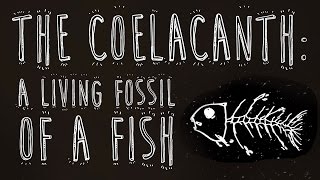(单词翻译:单击)
The dead coming back to life sounds scary.
死尸还魂听起来很可怕。
But for scientists, it can be a wonderful opportunity.
但对科学家来说,这可是绝佳的机会。
Of course, we're not talking about zombies.
当然,这里所说的可不是僵尸。
Rather, this particular opportunity came in the unlikely form of large, slow-moving fish called the coelacanth.
这死而复生的机会极少会出现,指的是庞大又迟缓的腔棘鱼。
This oddity dates back 360 million years,
这个怪物可以追溯到三亿六千万年前,
and was believed to have died out during the same mass extinction event that wiped out the dinosaurs 65 million years ago.
曾被认为在一场大灭绝中消失了,六千五百万年前的那场恐龙大灭绝。
To biologists and paleontologists, this creature was a very old and fascinating but entirely extinct fish, forever fossilized.
在生物学家和古生物学家看来,这种生物虽然古老又神奇,但却永远地灭绝了,只剩下化石。
That is, until 1938 when Marjorie Courtenay-Latimer, a curator at a South African museum,
直到1938年,南非的一个博物馆长,玛罗丽·考特内-拉蒂莫,
came across a prehistoric looking, gleaming blue fish hauled up at the nearby docks.
偶遇一条在附近码头被拖网渔船捕到的、长相很远古、闪着蓝光的鱼。
She had a hunch that this strange, 1.5 meter long specimen was important but couldn't preserve it in time to be studied and had it taxidermied.
直觉告诉她,这条1.5米长的鱼有着重要的意义,但她却没时间及时保存它以研究和制作标本。
When she finally was able to reach J.L.B. Smith, a local fish expert,
当她终于找到一位当地名叫J.L.B.史密斯的鱼类专家时,
he was able to confirm, at first site, that the creature was indeed a coelacanth.
专家一眼就确认了该生物就是腔棘鱼。
But it was another 14 years before a live specimen was found in the Comoros Islands,
但是又过了14年,人们才在科摩罗群岛发现了一个活体,
allowing scientists to closely study a creature that had barely evolved in 300 million years.
这让科学家有机会仔细研究这种300万年中没有进化过的生物。
A living fossil. Decades later, a second species was found near Indonesia.
真是活化石啊。几十年后,第二条鱼在印尼附近被发现。
The survival of creatures thought extinct for so long proved to be one of the biggest discoveries of the century.
很久以来腔棘鱼都被认为已经灭绝,它们的幸存被证明是20世纪最重大的发现之一。
But the fact that the coelacanth came back from the dead isn't all that makes this fish so astounding.
但腔棘鱼的令人震惊之处还不仅仅是它的起死回生。
Even more intriguing is the fact that genetically and morphologically,
更神奇的是,从基因或是形态上,
the coelacanth has more in common with four-limbed vertebrates than almost any other fish, and its smaller genome is ideal for study.
比起几乎所有其它的的鱼,它和四肢的脊椎动物更相近,而它较小的基因组也很适合研究。
This makes the coelacanth a powerful link between aquatic and land vertebrates,
这让腔棘鱼成功连接了水生生物和陆生脊椎动物,
a living record of their transition from water to land millions of years ago.
它更是鲜活地记录了数百万年前前者向后者的转变。
The secret to this transition is in the fins.
转变的秘密在于鱼鳍。

While the majority of ocean fish fall into the category of ray-finned fishes,
大多数的海洋鱼类都属于鳍刺鱼,
coelacanths are part of a much smaller, evolutionarily distinct group with thicker fins known as lobe-finned fish.
而腔棘鱼属于一小支进化得很独特的鱼类,有着更宽大鱼鳍的肉鳍鱼。
Six of the coelacanth's fins contain bones organized much like our limbs, with one bone connecting the fin to the body,
腔棘鱼身上有六个鱼鳍的结构与我们的四肢相似,都是一根骨头连着身体,
another two connecting the bone to the tip of the fin, and several small, finger-like bones at the tip.
再由两根骨头连向鳍尖,鳍尖又有几根像手指一样的小骨头。
Not only are those fins structured in pairs to move in a synchronized way,
腔棘鱼不仅把鳍长成一对一对以协调运动,
the coelacanth even shares the same genetic sequence that promotes limb development in land vertebrates.
甚至连促进四肢发育的基因序列也与陆生脊椎动物的相同。
So although the coelacanth itself isn't a land-walker,
因此,虽然腔棘鱼本身不在路上行走,
its fins do resemble those of its close relatives who first hauled their bodies onto land
但它的鱼鳍却与其近亲的极为相似,那些近亲首次拖着自己的身体登上陆地,
with the help of these sturdy, flexible appendages, acting as an evolutionary bridge to the land lovers that followed.
凭借的是灵活有力的鱼鳍,为后来的陆地的主人们搭起了进化的桥梁。
So that's how this prehistoric fish helps explain the evolutionary movement of vertebrates from water to land.
这也是为什么这种史前的鱼类解释了脊椎动物从水到陆的迁移。
Over millions of years, that transition led to the spread of all four-limbed animals, called tetrapods,
几百万年以来,这种转变使得所有四足动物拓展了自己的足迹,
like amphibians, birds, and even the mammals that are our ancestors.
比如两栖类,鸟类,甚至是我们的祖先哺乳类。
There's even another powerful clue in that unlike most fish, coelacanths don't lay eggs,
还有一条强有力的证据是:不同于大多数鱼类,腔棘鱼不产卵,
instead giving birth to live, young pups, just like mammals.
而是像哺乳动物一样生崽。
And this prehistoric fish will continue to provide us with fascinating information
相信这种史前鱼类将会继续带给我们惊喜,
about the migration of vertebrates out of the ocean over 300 million years ago.
告诉我们脊椎动物在3亿多年前离开海洋的故事。
A journey that ultimately drove our own evolution, survival and existence.
那是一场推动了人类自身的进化与生存的迁徙。
Today the coelacanth remains the symbol of the wondrous mysteries that remain to be uncovered by science.
今天,腔棘鱼仍是一个有待探索的自然之谜。
With so much left to learn about this fish, the ocean depths and evolution itself,
关于这条鱼,关于深海甚至关于进化本身,都还有太多等待着我们去发现,
who knows what other well-kept secrets our future discoveries may bring to life!
也许未来又会有其它不为人知的秘密被发现!


